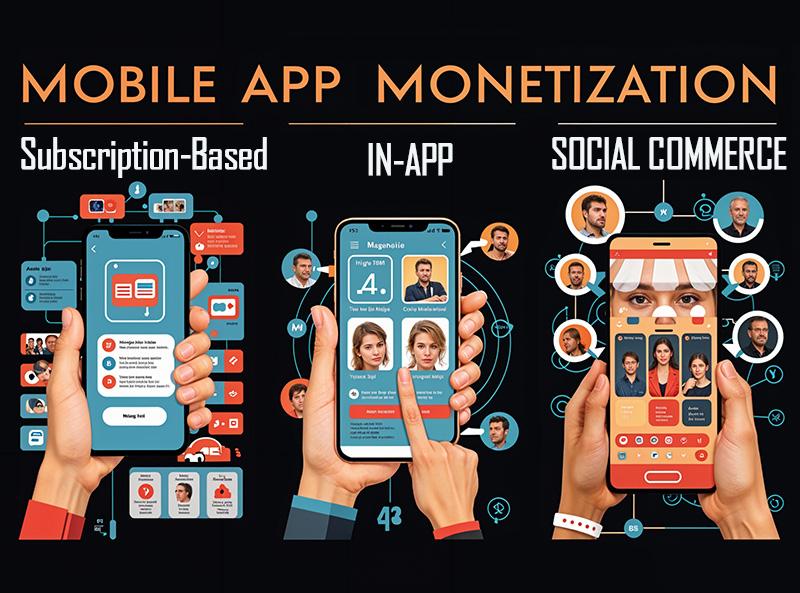

One of the most popular trends in mobile app monetization is the subscription model. This model involves users paying a recurring fee (monthly, quarterly, or annually) to access the app's content or features. Subscription apps are becoming increasingly popular, especially in the entertainment and education sectors. Services such as Netflix, Spotify, and Duolingo have successfully implemented this revenue model, generating significant revenue from their loyal subscribers.
The key to success with subscription apps is to provide high-quality, exclusive content that users are willing to pay for. This can be in the form of ad-free access, premium features, or access to a vast library of content. Additionally, developers must continuously provide updates and improvements to keep their subscribers engaged and satisfied.
Offering a free trial period can also be an effective way to attract new subscribers. During this period, users can experience the full range of features and content, which can encourage them to transition to a paid subscription. It's crucial to ensure that the transition from free to paid is smooth and that users perceive the value they receive as worth the cost.
Determining the right pricing for a subscription can be challenging. Developers need to consider the perceived value of their app, the competitive landscape, and the affordability for their target audience. Tiered pricing can allow for a wider range of options, catering to different levels of engagement and user commitment.
One effective strategy is to offer various subscription levels, such as a basic plan with limited features and a premium plan with all features unlocked. This allows users to choose the plan that best fits their needs and budget.
Subscription models rely heavily on maintaining a loyal user base. Developers must focus on retention strategies to minimize churn rates. Engagement tactics, such as personalized content, push notifications, and regular communication, can help keep users interested.
It's also important to analyze user behavior to understand why some users may cancel their subscriptions and address these issues. Providing excellent customer support and listening to user feedback can go a long way in retaining subscribers.
In-app advertising has been a staple in mobile app monetization for years, and it continues to be a significant revenue stream for developers. With in-app advertising, developers can display ads within their apps, allowing them to earn revenue from clicks or impressions. This revenue stream is particularly effective for free apps, as it allows developers to generate income without charging users for the app itself.
However, developers must be mindful of the user experience when implementing in-app ads. The choice of ad formats—such as banner ads, interstitials, video ads, or native ads—and their placement within the app can significantly impact the user experience. Too many ads or intrusive ads can lead to a negative user experience and result in users abandoning the app altogether.
Developers should carefully select ad formats that blend well with the app's design and provide value to the user. For instance, rewarded video ads that offer in-app incentives for watching can be a win-win for both developers and users.
It's essential to strike a balance between generating revenue and maintaining a positive user experience to retain and attract users. Developers must consider the frequency of ads, the relevance of the advertised content to the user, and the ease with which users can return to the app's content after engaging with an ad.
Using analytics to monitor user engagement and feedback can help developers optimize their ad strategy. A/B testing different ad placements and formats can also provide valuable insights into what works best for the app's user base.
With growing concerns over privacy and data security, it's important for developers to be transparent about their advertising practices. Clearly informing users about the use of their data for targeted advertising and providing options for users to control their ad preferences can build trust and loyalty.
Furthermore, adhering to industry standards and regulations, such as the General Data Protection Regulation (GDPR), is crucial to avoid legal issues and maintain a positive reputation.

As the name suggests, hybrid monetization involves combining multiple revenue streams to maximize revenue potential. This approach allows developers to diversify their income sources and cater to different user preferences. For example, a developer may choose to offer a subscription model for premium features, in-app advertising for free users, and in-app purchases for additional content or features.
Hybrid monetization can be a highly effective strategy, as it allows developers to reach a broader audience and cater to different user preferences. However, it requires careful planning and execution to ensure that the different revenue streams work together seamlessly and do not disrupt the user experience.
Developers must ensure that each revenue stream is integrated in a way that feels natural and adds value. For instance, in-app purchases should complement the subscription offerings, not compete with them.
Understanding the user base is key to successfully implementing a hybrid monetization model. Analytics can provide insights into user behavior, preferences, and willingness to spend within the app. This data can help developers tailor their monetization approach to suit their audience.
Segmenting the user base and targeting different groups with appropriate monetization tactics can also be beneficial. For example, offering in-app purchases of cosmetic items might appeal to one segment, while another may be more interested in purchasing time-saving features.
With multiple monetization methods in place, it's important to manage user expectations clearly. Users should understand what they get for free, what requires payment, and the benefits of each option. Clear communication and transparency can prevent confusion and frustration, which could lead to user churn.
Providing options for users to switch between different monetization methods, such as moving from a free ad-supported version to a paid subscription, gives users control over their experience and can increase satisfaction and loyalty.
Devant IT Solutions, a leading mobile app development company, has successfully implemented these emerging trends in their mobile app monetization strategies. One of their most successful apps, "RWOOD" follows a subscription model, allowing users to unlock premium features for a monthly fee. They also offer in-app advertising for free users, generating additional revenue through ad clicks and impressions.
Their "RWOOD" app showcases the effectiveness of a subscription-based model. With a focus on providing a powerful toolset for productivity, the app has attracted a significant number of subscribers who find value in the premium features offered. Devant IT Solutions has also implemented features like data syncing and cross-platform support to justify the subscription cost and enhance user retention.
Their other app, "Recipe Book," follows a hybrid monetization strategy, offering a subscription model for access to exclusive recipes and in-app purchases for additional recipe packs. This approach has allowed them to cater to different user preferences and generate significant revenue from both streams.
By analyzing user interaction and feedback, Devant IT Solutions was able to identify which recipes and features were most popular, thus informing their strategy for creating additional paid content packs that complement the subscription offering.
The experience of Devant IT Solutions illustrates the importance of adaptability in monetization strategies. They have shown that being responsive to user feedback and willing to adjust their approach can lead to increased revenue and user satisfaction. Their success also underscores the need for high-quality content and features that users are willing to pay for.
With the various monetization options available, it can be challenging to determine the best strategy for your app. Here are some factors to consider when choosing the right monetization strategy for your app:
Your target audience plays a crucial role in determining the most effective monetization strategy for your app. For example, if your app is targeted towards young adults, they may be more receptive to in-app advertising, whereas an older audience may prefer a subscription model.
Understanding the demographics, preferences, and spending habits of your target audience can guide your choice of monetization. Conducting surveys and user testing can reveal insights into what your audience values and is willing to pay for.
The type of app you have developed can also influence the most effective monetization strategy. For example, a gaming app may be better suited for in-app purchases, while an educational app may benefit from a subscription model.
Analyzing successful apps in your category can provide a blueprint for what might work for your own app. It's also important to consider how users typically engage with apps in your category—are they looking for quick, casual experiences, or do they invest significant time and resources into the app?
It's essential to research your competition and see what monetization strategies they have implemented successfully. This can give you insights into what works and what doesn't in your specific niche.
Observing how competitors balance monetization with user experience can also provide valuable lessons. You may identify gaps in the market where your app could provide a unique value proposition.
Ultimately, the user experience should be at the forefront of your decision when choosing a monetization strategy. Users are more likely to continue using an app that offers a seamless, positive experience without too many interruptions.
When choosing a monetization strategy, prioritize methods that integrate smoothly with the app's design and functionality. Consider how monetization impacts every aspect of the user journey, from onboarding to regular usage, and make adjustments as needed to enhance the overall experience.
In conclusion, mobile app monetization is a vital aspect of a developer's strategy and requires careful consideration to maximize revenue potential. With the increasing popularity of subscription apps, in-app advertising, and hybrid monetization, developers have a range of options to choose from. However, it's crucial to choose a strategy that aligns with your app's target audience and category while also maintaining a positive user experience. By following these trends and considering these factors, developers can effectively monetize their apps and achieve their revenue goals.